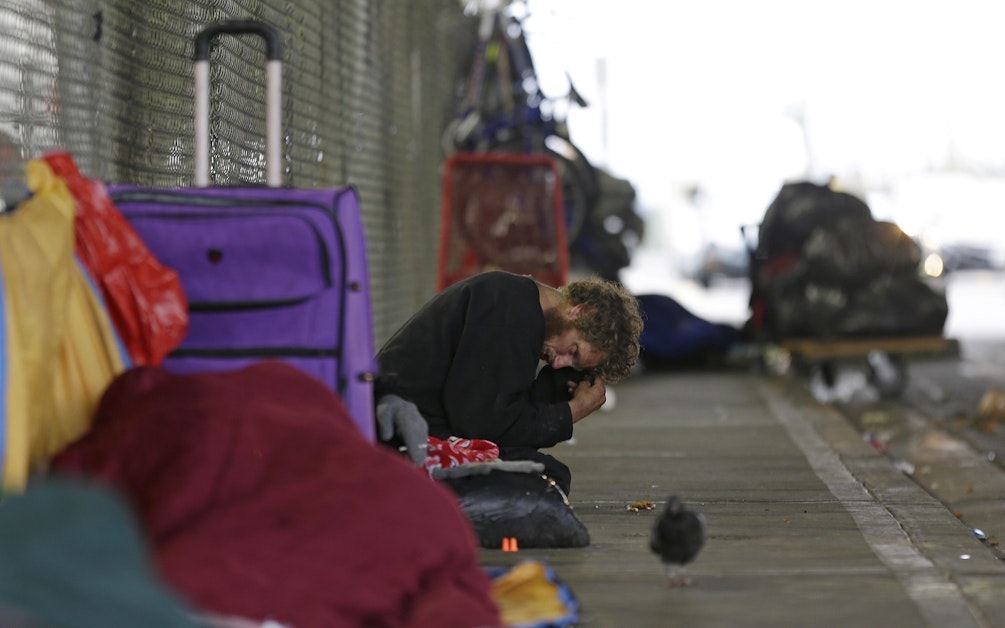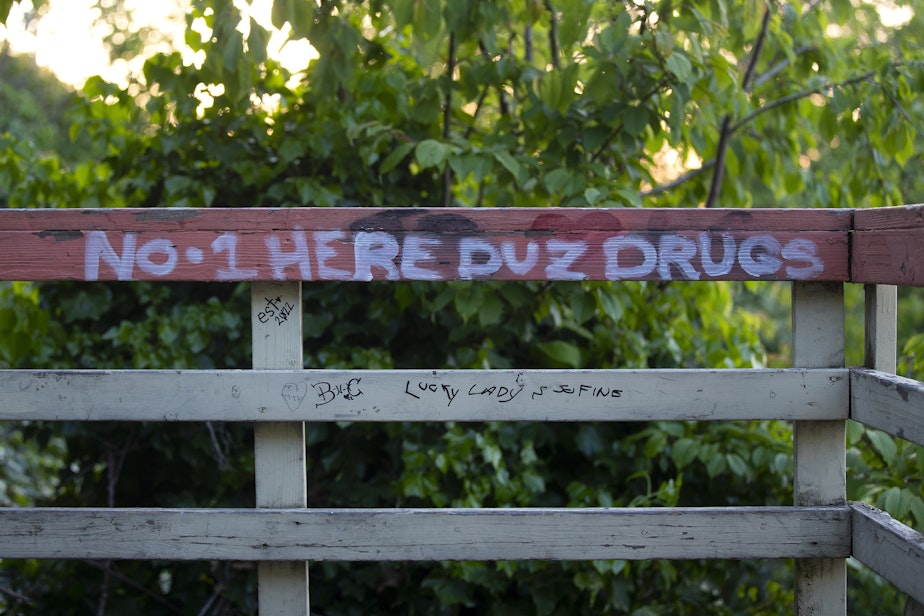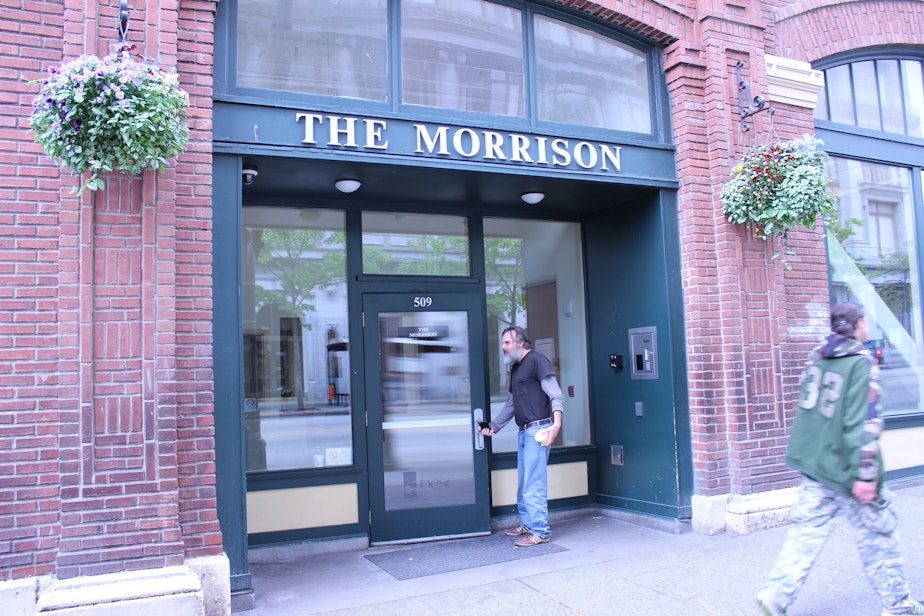Seattle, WA
Seattle’s troubled past and present suggest a new approach to mental health

E
dward Moore, a 32-year-old sailor, was discovered, near freezing and living in a tattered tent on the shore near current day Seattle in 1854. At the time, Washington was still a territory and Seattle was a misty settlement of log cabins and wood-framed homes at the edge of the known world.
“He’d been living in his makeshift tent for months, living off raw shellfish he foraged and being cared for after a fashion by the Coast Salish people who lived nearby,” explained Josephine Ensign, a University of Washington nursing professor, and the author of “Skid Road,” which documents the history of homelessness in Seattle.
“He most likely had PTSD from a really, really bad shipwreck and maybe also potentially some traumas from his childhood back in Massachusetts,” Ensign said. “It does seem like he had schizophrenia or some type of psychosis.”
After having several of his frost-bitten toes amputated with an axe, Moore was taken to a doctor at Fort Steilacoom, which would later become Western State Hospital.
But when the bill came due for Moore’s care, Washington lawmakers balked. They didn’t want to set a precedent that would require the territory to care for the growing number of poor and ill sailors who were ending up on its rugged shores.
They decided Moore’s care was the responsibility of the county, not the territory, and shipped him back to Seattle by canoe. After he returned, Seattleites decided the best thing to do was to send Moore back to Massachusetts.
“Townspeople took a collection to buy him a new pair of clothes, paid a ship’s captain, and shipped him off,” Ensign said.
Living on the East Coast with his sister and elderly parents, without treatment for his mental illness, Moore didn’t last long.
“The cause of death was hanging,” Ensign said. “And it says, ‘Cause: Insanity.’”
Moore’s story and his death carry disturbing parallels to current-day treatment of mental illness and may also contain a message about how the region could better manage both mental illness and homelessness in the years to come. At the core of this message is the ability, or in most cases, inability, to see mental illness from the perspective of those who suffer from it.
RELATED: Vulnerable patients caught in ‘churn’ between Washington mental health care systems face life and death circumstances
Many of the gaps in mental health care stem from the assumptions made about the capacity of people to cope with day to day activities once they are “cured.”
“We have sort of the crisis management of the inpatient unit and then the outpatient treatment, which assumes that you can manage all areas of your life,” said Katherine Jonas, who researches psychosis at Stony Brook University in New York. “You can get yourself to an outpatient clinic. You can fill the prescription and remember to take them. And then there’s nothing in between.”

L
ew Middleton lived in a state of turmoil for years because he heard and obeyed the many voices in his head. The voices drove Middleton into the forests of Washington state, where he lived while they reinforced his delusions.
“What I noticed was the more I collectively listened to them and the more I thought about maybe people chasing me, the more it became people chasing me,” he said.
One night, Middleton ran into an ex-girlfriend. He showed her the bite marks he had on his arm from a fight he’d been in, and she convinced him to go to the hospital, where he was admitted to Harborview Medical Center, one of the only hospitals in the Seattle area with a specific unit for psychiatric emergencies.
Middleton thought he’d been abducted and the anti-psychotic medicine he was prescribed was poison. But he took it and he began to notice a change.
“The voices didn’t go away completely,” he said. “It just kind of brought it down to the point of where they weren’t so loud.”
RELATED: 50 years ago, many psychiatric hospitals closed. Did that cause today’s mental health crisis?
The antipsychotics that Middleton was prescribed in the 1990s hadn’t changed much since they came out in the 1950s and there have been few game-changing breakthroughs in those medications in the 30 years since.
“I work toward de-prescribing because people come out of the hospital with tons of medications, over-prescribed, really just kind of shells of people when they come out,” explained Alix Van Hollebeke, the head of nursing at Seattle’s Downtown Emergency Center, a nonprofit near Harborview that provides shelter, housing, and medical care to people with complex cases of mental illness and substance abuse.
“We want to get to the point where they get to live their life, even if it’s weird and different and we don’t understand what it’s like, but they get to live their life as they want to live it. With maybe a little bit more sparkle than the rest of us,” Van Hollebeke said.
While the antipsychotics helped lower the voices Middleton heard, they did not silence those voices. They also caused side effects such as facial tics and other involuntary movements. Other meds seemed to make the voices louder.
His mom worried he’d wind up dead. But getting him committed was nearly impossible
But the treatment and care gave Middleton the ability to separate from the voices and helped him understand they were a part of him that he could reason with and learn to live with.
“It’s almost like I was playing this role like, almost like a movie, a role where I was believing everything that was going on and as soon as I tested it, the reality came through,” Middleton said. “There was nobody out there chasing me.”

Middleton went on to work at the Downtown Emergency Center and became the longest served certified peer counselor in Washington state history. The center now has a drop-in center named after him.
While some people who suffer from mental illness are able to gain stability through a combination of care and recovery, others require ongoing care that is difficult to find in the current mental health system.
D
onald is a psychiatrist who dealt for years with his son Eli going through “the churn,” spending time in psychiatric hospitals, emergency rooms, living on the street, and seeking relief through alcohol and drugs.
Donald and his wife, who asked that their last name not be used to protect his son’s identity, reached a critical moment when their son was about to be arrested and he turned to his parents and asked, with a look of terror in his eyes, “Please, can’t I stay with you?”
RELATED: A boy named Adam: When psychosis spills onto Seattle streets
They could not turn him down. Donald and his wife now provide their son with 24-hour care. Their lives revolve around Eli’s daily needs for routine and consistency.
They avoid sarcasm and innuendo, which they have found lend to Eli’s paranoia and can erupt into psychosis.
“How do I help him mitigate the terror he’s experiencing?” Donald asked. “The terror is terror, whether it’s internally induced or whether it’s externally induced, it’s terror. And it’s in the eyes, his eyes.”

The process of living with Eli made Donald recognize aspects of mental health care that potentially contributed to psychosis and delusion, rather than offering relief and stability. For example, not being able to sleep in a hospital because a roommate is yelling, or being overdosed on medications, then released without assistance and suffering a fall.
At the core of this frustration with his own field of psychiatry was the mistaken attitude he described as “doctors know best.” Donald did not see a genuine curiosity about the way people in psychosis were experiencing the world. He realized that mental health care, as with the “care” offered to Edward Moore on the shores of Seattle 170 years ago, was based not on the needs of the people who are sick, but on what is expedient for the rest of us.
“The quickest way is to do what we’ve done for centuries, which is to lock people away unseen and to make people invisible and less disruptive so that’s what we do,” he said.
RELATED: Who was Lillian Massey? A journey to Northern State psychiatric hospital
One of the things that offers Donald hope is the compassion he sees in his son Eli when he encounters other people in mental distress. The first thing he thinks of when he sees someone in pain is not how he can change or fix them.
“Most people, if they can calm their minds down, and that takes time, it’ll be the same for them, all of us,” Donald said. “It doesn’t take a lot of know-how to offer somebody or ask them a question. What can I do to help you?”
To listen to the full episode of “Lost Patients,” tap the link above.
Looking for mental health resources? KUOW compiled an “Acute mental health resource guide” that can help.

Seattle, WA
Seattle Weather: Mild day with increasing clouds, later showers Friday

Mild day with increasing clouds, later showers Friday
A sunny and clear start to the day Friday with only a few clouds. High clouds will start to increase into the afternoon as rain slowly moves in along the coast.
Plenty of sunshine and warmer temperatures today, finally above average after a cooler week. Highs topped out in the upper 50s.
Tonight, we will see temperatures a few degrees warmer than the last several nights along with plenty of clear skies. Lows in the upper 30s to low 40s.

A sunny and clear start to the day Friday with only a few clouds. High clouds will start to increase into the afternoon as rain slowly moves in along the coast.

Showers will move in along the coast and just west of I-5 by around 5pm, slowly making their way further inland by later into the evening.

Highs will still be warm and above average around the Puget Sound. A little cooler along the coast with the rain moving in for the afternoon. Highs will be above average in the mid 60s.

Regional Highs Tomorrow
The weekend will be cool and wet, with more showers continuing into early next week. Skies will slowly clear and warm up by the middle of the week.

Seattle, WA
Seattle Seahawks GM shares thoughts on this year's draft strategy

The Seattle Seahawks didn’t do anything wildly unpredictable in the NFL Draft this past weekend.
Seahawks Draft Grades: Insider on best pick, biggest reach
Sure, it was a bit surprising that they drafted a pair of cornerbacks in the fifth and sixth rounds, given that corner already seemed to be one of the stronger position groups on the team. And yes, they took a flier on a little-known Division II offensive tackle in the seventh round.
But overall, it seemed like a very systematic draft for the Seahawks. They had clear needs at a handful of position groups, and for the most part, they appeared to address them.
They used their first-round pick to beef up their interior defensive line, taking Texas defensive tackle Byron Murphy II at No. 16 overall. They added manpower to their interior offensive line, drafting UConn guard Christian Haynes in the third round and Utah guard Sataoa Laumea in the sixth. And with their fourth-round selections of UTEP linebacker Tyrice Knight and Michigan tight end AJ Barner, they gained depth at two spots that desperately needed it.
During his appearance Thursday on Seattle Sports’ Wyman and Bob, Seahawks general manager John Schneider shared a similar view on how the draft went.
“We had groupings throughout the board and we had touch points, and we got to them,” Schneider said. “We had a couple of times where we were going to move around, we didn’t. We were going to move up, we didn’t. You know, (at No.) 16, we stayed, waited. It didn’t feel like a draft to be trying to be like the smartest guy in the room and trying to be moving all over the place. It felt like a draft, like, ‘Hey, we have buy-in with a new staff on these areas. Let’s hit these areas and then grow from here.’”
Murphy was ‘primary guy on defense to go get’
The draft began with a record run of 14 consecutive offensive players selected, which ultimately benefited the Seahawks by making the top defensive prospects available to them at No. 16 overall.
The Indianapolis Colts finally broke the streak of offensive picks at No. 15, taking edge rusher Laiatu Latu out of UCLA. That allowed Seattle to take Murphy, who the Seahawks said they viewed as the best defensive player in the draft.
The 6-foot-1, 297-pound Murphy was a game-wreaking force at Texas and gives new Seattle coach Mike Macdonald a potential big-time disruptor at defensive tackle.
“We had several (offensive players) that we just knew weren’t going to be there,” Schneider said. “We were prepared for them to be there if they came, but … I personally think it’s like divine that you’re kind of focused on one individual and he felt like the guy all the time. You know, a couple offensive players just didn’t make it there, and we weren’t in a position to go get somebody either. … (But) he was obviously the primary guy on defense to go get.”
Listen to the full conversation with Seahawks general manager John Schneider at this link or in the audio player near the middle of this story.
More Seattle Seahawks coverage
• Ranked: Seahawks’ top 5 position group battles after draft
• There’s a very telling story behind Seahawks drafting Murphy
• Are Seahawks going to reunite with polarizing Jamal Adams?
• With draft complete, what is Seahawks’ biggest question mark?
• Huard explains why Seattle Seahawks drafted two cornerbacks
Seattle, WA
What to know ahead of Justin Timberlake's Seattle shows

SEATTLE – Justin Timberlake is in Seattle for his “The Forget Tomorrow” World Tour, as he performs in Climate Pledge Arena this week!
Here are a few things to know before the Prince of Pop takes the stage:
When are the shows?
Timberlake has two shows at Climate Pledge, one on Thursday and another on Friday. Both start at 7:30 p.m.
Can I still get tickets?
Yes, tickets are still available on Ticketmaster. Prices range from $70-$400+
What can I expect at the show?
This is Timberlake’s first tour in five years, in support of his sixth studio album, “Everything I Thought It Was.” Fans should expect Justin to perform a few singles from his latest release, likely including “Selfish”, “Drown”, and “No Angels”.
If you’re shopping for exclusive concert merch, Justin Timberlake’s website has all the goodies you’ll want to check out.
Not much is known about how his set will look, as it’s only his second show of the world tour. However, his first show in Vancouver featured an elevated, rotating stage, meaning Justin could have something special planned for the Emerald City!
Online, it appears there’s a second stage across the floor section in the VIP area. It’ll be a performance fans will just have to wait to see!
Where should I park?
If public transportation or other means of transport aren’t an option for you, there are several parking garages concert-goers can use. There’s a parking garage south of the arena on Lenny Wilkens Way, and another on the east side of the Seattle Center campus on Harrison Street. Parking costs $63 for the one near the arena, and $35 for the other that’s a seven-minute walk away.
However, public transportation, the Seattle Center monorail, or other rideshare options are highly encouraged for getting to the venue.
How long is the tour?
Justin’s world tour spans until December 16, ending in Indianapolis. If you can’t make the Seattle shows, there are plenty of other opportunities to catch Timberlake live. See his full concert schedule online.
MORE FOX 13 SEATTLE NEWS:
Catch these shows at WA’s Gorge Amphitheatre this summer
WA businesses poke fun at escaped zebra in North Bend
Mayor Harrell hires firm to investigate sexual harassment claims against SPD leaders
Teens arrested in Bellevue carjacking linked to $100,000 retail theft
To get the best local news, weather and sports in Seattle for free, sign up for the daily FOX 13 Seattle newsletter.
-

 News1 week ago
News1 week agoLarry Webb’s deathbed confession solves 2000 cold case murder of Susan and Natasha Carter, 10, whose remains were found hours after he died
-

 World1 week ago
World1 week agoHaiti Prime Minister Ariel Henry resigns, transitional council takes power
-

 News1 week ago
News1 week agoFirst cargo ship passes through new channel since Baltimore bridge collapse
-

 World1 week ago
World1 week agoUS secretly sent long-range ATACMS weapons to Ukraine
-

 World1 week ago
World1 week agoSpanish PM Pedro Sanchez suspends public duties to 'reflect'
-

 News1 week ago
News1 week agoAmerican Airlines passenger alleges discrimination over use of first-class restroom
-

 Movie Reviews1 week ago
Movie Reviews1 week agoHumane (2024) – Movie Review
-

 Education1 week ago
Education1 week agoVideo: Johnson Condemns Pro-Palestinian Protests at Columbia University
















